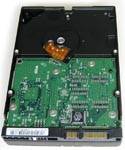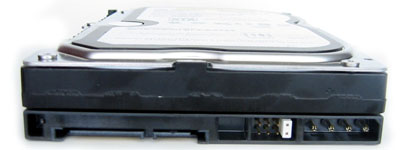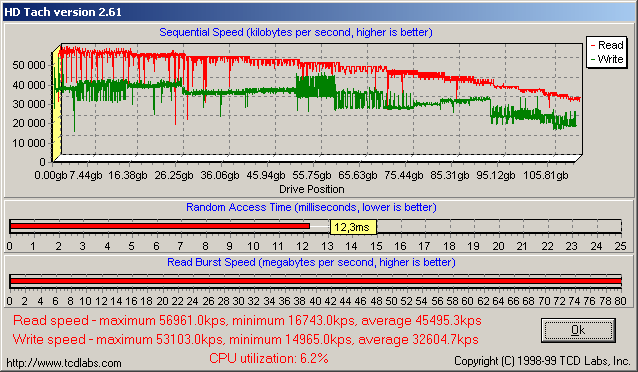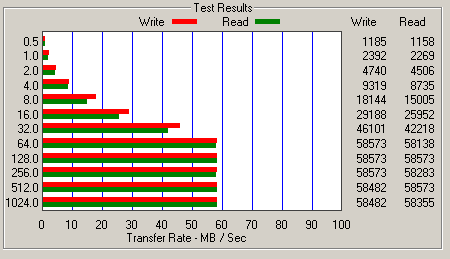First off, we have Western Digital’s new Raptor with a rotation speed of a whopping 10 000 revolutions per minute, hinting about good access times.
Its competitors are Western Digital’s and Seagate’s mainstream harddrives, namely 120 GB models with 8 MB cache. Both Seagate’s Barracuda and Western’s Raptor are equipped with SATA; the new harddrive interface whose popularity increases quite fast on the market.
When it comes
to storage, we at NordicHardware have been a bit lazy lately. However, today
we will take a closer look at three harddrives with pretty different characteristics
to remedy this period of inactivity.
First off, we have Western Digital’s new Raptor with a rotation speed of a
whopping 10 000 revolutions per minute, hinting about good access times.
Its competitors are Western Digital’s and Seagate’s mainstream harddrives,
namely 120 GB models with 8 MB cache. Both Seagate’s Barracuda and Western’s
Raptor are equipped with SATA; the new harddrive interface whose popularity
increases quite fast on the market.
|
Specifications:
Western Digital Raptor 36.7GB |
|
| Storage capacity |
36.7
GB |
| Rotation speed |
10
000 RPM |
| Access time |
5.2
ms |
| Cache size |
8
MB |
| Interface |
SATA
|
| Accessories |
–
|
| Noise-level |
32
dBA |
With its pitiful
36.7 GB, the storage capacity is hardly something to write home about. Compared
to the giants of today, it’s almost ridiculously little storage space. Has
Western Digital, known to be far ahead in development, made a big mistake,
or what’s it all about? Of course not. A closer look at the specifications
reveals that this is a neat little speeder that spins at fully 10000 RPM.
The number of revolutions per minute (RPM) largely, though not totally, decides
how fast the harddrive is; the faster the discs spins, the lower average access
time.
The seek time
is not bad either. With a mere 5.2 ms, Western Digital sets a new record in
terms of non-SCSI connected harddrives. Obviously, this speed merchant is
equipped with the new SATA interface, which allows for a theoretical transfer
speed of 150 MB/s, compared to the 133 MB per second that ATA133 offers. Sadly,
there are no harddrives that can deliver 150 MB per second, but SATA has got
many pros against the former PATA version (also called ATA and sometimes IDE),
having nothing to do with the transfer speed. First of all, the cables are
much thinner, thus increasing air circulation in the case and allowing for
the cables to be better arranged. Furthermore, the CPU load becomes a tad
lower, and as if it that wasn’t enough, the SATA interface is Hot-Swap compatible,
making it possible to add and remove your harddrives during operation without
any problems. Isn’t that something that you always have dreamt of? Maybe not
the most useful feature ever invented, but as long as there aren’t any cons,
just go ahead!
|
|
|
The harddrive
is also equipped with the 8 MB cache memory, which has become a standard at
Western Digital; the Special Edition harddrives are suddenly not so special
anymore. Most harddrive manufacturers equip their better models with 8 MB
cache, so it’s not unexpected that this harddrive is equally endowed. According
to the specifications, the harddrive generates 32 dBA of noise, which is very
little considering the high RPM.
The Raptor is
quite much heavier than a regular 3,5" harddrive, and has a built-in
heatsink to better handle the heat generated by the fast spinning drive. Apart
from the heatsink, the harddrive looks like something from the 80’s with its
shell looking awfully old-fashioned. Somewhat boring for a super-fast harddrive,
but how many are really staring at their harddrives frequently?
The connection
aspect is very unlike ordinary PATA disks; firstly, there is no wide connector
for the data cable. The data cable is actually the thinnest of all the three
available connections. Moreover, there are two power connections; one for
the new SATA power connector and one for the old molex connector. Remember
to only use one of these connections at the time, or you might destroy the
harddrive. The PCB is designed in such a way that every chip except one is
on the inside, for better and worse. That makes the harddrive less sensitive
to static discharges, but the major part of the heat from the chips gets trapped
inside the drive with the motor.
|
|
Something that
I thought would be gone was the jumpers on the backside. They shouldn’t be
needed since SATA only uses one harddrive per channel. Because of this, you
don’t have to set master/slave, and therefore the jumpers should be unnecessary.
The jumper block does sit there, however, completely unnecessary as it seems.
There is a jumper that short-circuits two pins as standard, but according
to WD’s homepage, it doesn’t matter whether the jumper is removed. The two
in the middle are not connected, and the last one makes the harddrive start
in "standby" mode. What that means is still a mystery as I never
noticed any difference at all when I fiddled with the jumper.




































